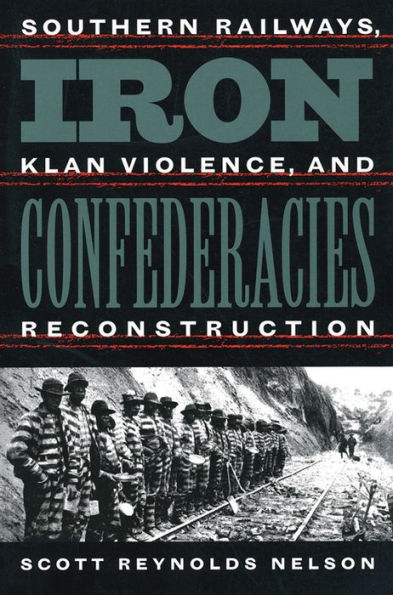
Iron Confederacies: Southern Railways, Klan Violence, and Reconstruction
272
Iron Confederacies: Southern Railways, Klan Violence, and Reconstruction
272eBook
Related collections and offers
Overview
Iron Confederacies uses the history of southern railways to explore linkages among the themes of states' rights, racial violence, labor strife, and big business in the nineteenth-century South. By 1868, Ku Klux Klan leaders had begun mobilizing white resentment against rapid economic change by asserting that railroad consolidation led to political corruption and black economic success. As Nelson notes, some of the Klan's most violent activity was concentrated along the Richmond-Atlanta rail corridor. But conflicts over railroads were eventually resolved, he argues, in agreements between northern railroad barons and Klan leaders that allowed white terrorism against black voters while surrendering states' control over the southern economy.

Product Details
| ISBN-13: | 9780807876107 |
|---|---|
| Publisher: | The University of North Carolina Press |
| Publication date: | 10/12/2005 |
| Sold by: | Barnes & Noble |
| Format: | eBook |
| Pages: | 272 |
| Sales rank: | 1,062,529 |
| File size: | 2 MB |
About the Author
Table of Contents
Contents
Acknowledgments Introduction
1. Forcing Nature: An Iron Confederacy Surveyed and Graded
2. The Confederacy Serves the South(ern)
3. Connections: Political Reconstruction and the Public Fiction of the Air Line, 1865-1871
4. The Pennsylvania Railroad's Consolidation, and the Return of the Confederacy
5. Alamance: A Trenchant Blade
6. Pockets Full of Executions: The Railway Corridor in South Carolina
7. Public Fictions
8. A Railway Redemption Conclusion: An Ironic Confederacy Notes Select Bibliography Index
Maps
1. Core Railway Lines from Atlanta to Richmond, 1868
2. Proposed Line from Washington to Atlanta, 1867
3. Southern Railway Security Company Lines, 1871
Illustrations
Union soldiers at the Richmond and Petersburg Railroad depot Convict laborers, probably on the Western North Carolina Railroad Railway workers near Murfreesboro, Tennessee Conflict over Reconstruction portrayed as a railroad accident The U.S. Military Railroad Construction Corps Thomas A. Scott of the Pennsylvania Railroad Thomas A. Scott's Union Station in Washington, D.C.
"A Political Discussion"
"Electioneering at the South"
White men whipping a black female African American men outside an "eating saloon" in South Carolina Western North Carolina Klansmen surrounding Republican John Campbell Freed people in South Carolina outside the offices of the Freedman's Bureau The lobby of the Kimball House Slaves at work on the North Carolina Railroad Advertisement for the Atlanta & Richmond Air Line A new steam-powered cotton gin in Aiken, South Carolina
What People are Saying About This
This impressive book combines penetrating knowledge of the financial and managerial aspects of railroad building with a compelling grassroots depiction of social change and conflict. It advances our understanding of the economics, racial, and social aspects of Reconstruction in a significant way. As an added bonus, the writing is clear and lively.
—(Paul D. Escott, Wake Forest University)
The story is captivatingly written, briskly paced, and contains a wealth of detail.—Journal of Southern History
Nelson's truly innovative insights, solid research, and narrative skill make his book a significant and welcome contribution that will stimulate years of important discussion on the nature of Reconstruction.—American Historical Review
Iron Confederacies leaps immediately to the top of the pile of books written about nineteenth-century southern railroads. Scott Nelson has imaginatively run his train of thought over the trunk lines of other scholars, and laid new tracks of his own as well. The result is a volume that does not merely challenge long-held notions about railroads, development, and southern politics, but also offers a new perspective on North-South relations during the era of Redemption.—Virginia Magazine of History and Biography
Iron Confederacies weaves disparate strands together into a seamless whole. A concise summary cannot do justice to this pithy and polished book, which displays exceptional wit. Suffice it to note that it is a sparkling example of scholarship that moves effortlessly across the boundaries of business, social, and political history.—Journal of American History
An outstanding work in social history. . . . Nelson writes in a simple and lively style.—Southern Historian
[A] fine study, which offers new and fresh interpretations and does so by integrating a range of disciplines.—Civil War Book Review
[This] new book tracing the contributions of slave labor to one sector of the economy helps to concretize the reparations question.—Jack Beatty, Atlantic Unbound
This impressive book combines penetrating knowledge of the financial and managerial aspects of railroad building with a compelling grassroots depiction of social change and conflict. It advances our understanding of the economic, racial, and social aspects of Reconstruction in a significant way. As an added bonus, the writing is clear and lively.—Paul D. Escott, Wake Forest University
